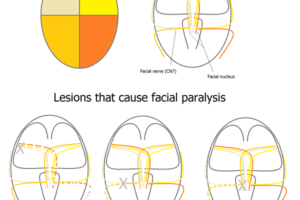The diencephalon contains several structures, each with the term “thalamus.” Most of these structures derive from the developmental vesicle called the diencephalon. The contents of the diencephalon include the dorsal thalamus (commonly called the thalamus), the subthalamus, epithalamus and the hypothalamus. The pineal gland is also part of the diencephalon.
Hypothalamus
The hypothalamus is dealt with in detail in its own section, so we only briefly review its anatomy and location here for completeness. Diagram of the anatomy of the thalamus.
The hypothalamus sits below (ventral) to the thalamus. It is responsible for many homeostatic functions, including, among others, temperature control, satiety, fluid balance, and circadian rhythms.
Given its diverse homeostatic functions, it is understandable that the hypothalamus receives inputs from a wide diversity of sites. Most of its cortical inputs come from the limbic system. Equally important, it detects blood-borne hormonal and chemical signals. Its major outputs include projections to the neural portion of the pituitary gland, reciprocal connections to the limbic system, and connections with brainstem and spinal cord nuclei.
Blood supply to the hypothalamus comes from perforating branches directly off the Circle of Willis.
Subthalamus
Most of the subthalamus is just a rostral extension of the midbrain, with parts of the substantia nigra and the red nucleus, and the midbrain reticular formation, which is called the zona incerta in the subthalamus. In addition, it contains one nucleus, conveniently called the subthalamic nucleus. The subthalamic nucleus plays a role in motor control and is interconnected with the basal ganglia.
Epithalamus
The epithalamus consists of the pineal gland and habenular nuclei.
Pineal gland
The pineal gland controls endocrine functions that depend on the length of the day. In lower vertebrates the pineal gland contains photoreceptors and directly measures the length of a day by the amount and duration of light it receives. In mammals (and birds) there are no photoreceptors in the pineal gland, but it does receive input from the visual system.
In the dark the pineal gland secretes melatonin. As days get longer in the spring melatonin secretion decreases, which, in many mammals, induces fertility in both males and females. Recent evidence also suggests that melatonin levels affect immune responses
Habenula
The nuclei of the habenula receive input from the stria meduallaris of the thalamus and project out through the habenulointerpeduncular tract. This is a rarely discussed pathway that seems to connect the limbic system and the reticular formation of the brainstem. This connection suggests a role in mediating the influence of the limbic system on arousal states.
Structures to identify on sections
To have a good handle on the anatomy of the hypothalamus, be able to identify the structures shown in Nolte pp. 562-563.
References
The most authoritative online reference of thalamus is written by S. Murray Sherman, of Neurobiology at the University of Chicago.
J. Nolte (2002) The Human Brain: An introduction to its functional anatomy. 5th edition. Mosby, Inc. St. Louis. Ch. 16.
C Luco, A Hoppe, M Schweitzer, X Vicuna and A Fantin (1992) Visual field defects in vascular lesions of the lateral geniculate body. Journal of Neurology, Neurosurgery, and Psychiatry. 55:12-15.

